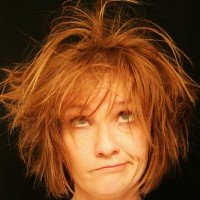Kids with Hair Loss Get Help From Stem Cells
Kids Shunned for Hair Loss Get Help From Their Own Stem Cells
July 10 (Bloomberg) — Children with alopecia areata, a condition that causes extensive, sometimes complete hair loss, grew hair after being injected with stem cells drawn from their own scalp in a small study.
Most of the five girls and three boys who had widespread baldness showed regrowth of as much as half of their hair in a preliminary study from Marwa Fawzi, a dermatologist at the University of Cairo Faculty of Medicine. Before the experimental treatment, some of the children had splotches of hair and baldness; others were almost totally bald.
Alopecia areata can occur at any age in either gender and there are no FDA-approved treatments, according to the National Alopecia Areata Foundation. Researchers believe people may be genetically predisposed to the condition, which can be aggravated by stress, Fawzi said. Children who get it are often shunned and teased by others, she said in an interview today at the annual meeting of the International Society for Stem Cell Research in Barcelona, Spain, where she presented her findings.
“It’s an emotionally devastating disorder for children,” she said.
Alopecia areata is distinct from the more common male pattern baldness that many men endure as they age. Fawzi has not tested the stem-cell injection treatment for male pattern baldness.
The Cairo researcher took small amounts of skin from the scalps of the children, isolated the hair follicle stem cells that stimulate hair production, and grew them in the lab, increasing the number of cells. After one month, she put the cells back into the scalps of the children, with numerous injections across the bald areas of their heads.
Hair Regrowth
She evaluated the children at one, three and six months after the injections. At the six-month mark, five of the children had at least a 50 percent increase in the amount of hair on their heads, two patients had a smaller increase and one had no change in quantity of hair, she said.
She also took new skin samples and examined the hair follicles themselves and could see that the injected stem cells had migrated into the follicles. There, the stem cells stimulated the follicles to transition from a dormant phase to a hair-generating phase, Fawzi said.
In a poster that she presented at the meeting, she showed photographs of an 8-year-old boy named Mahmoud who was almost completely bald before the treatment and had a nearly full head of hair afterward.
Mahmoud was socially isolated before and always wore a hat to hide his baldness, she said. He now calls her almost every day to talk and thank her for the treatment.
Fawzi plans a larger study of at least 30 children to test the treatment. Each child will receive stem-cell injections in some of the bald areas of their head and placebo injections in others. She will then be able to evaluate the differences in a controlled way, she said.
If the treatment works, she plans to look into its usefulness for androgenic alopecia, better known as male pattern baldness.
To contact the reporter on this story: Rob Waters in San Francisco at rwaters5@bloomberg.net.
Last Updated: July 10, 2009 15:03 EDT
More encouraging news for those with alopecia areata!
 |
Look Good, Feel Great! |  |
| Dale Lorna Denison P.S. For great styling tips for Women with Thinning Hair, check out my FREE Styling Guide –> |




